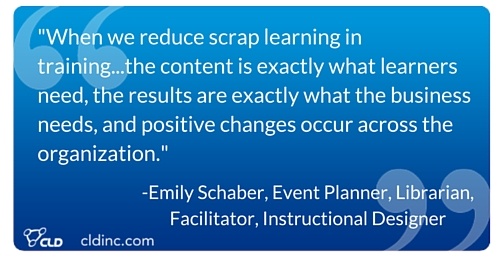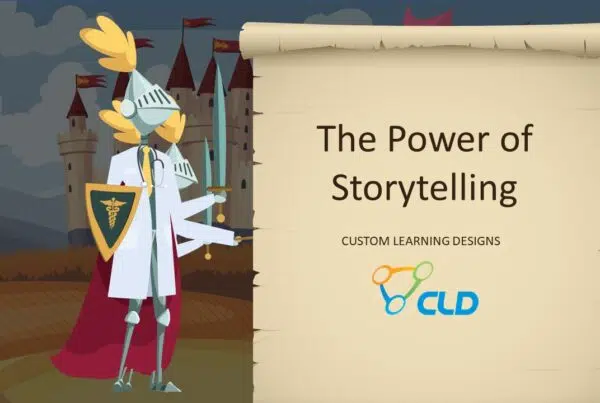
One study found that just under 20% of learners don’t apply on the job what they learn in a training program. Nearly two-thirds attempt to apply their learning, but go back to doing things the way they did before. Another study reported that in the typical organization, 45% of what is learned is not applied on the job. That’s a lot of wasted time for trainers and trainees!
Fortunately, being able to recognize it for what it is, understanding its causes, and learning how to predict which learning will “stick” are ways your organization can minimize wasted training time and effort so you can maximize ROI of your training investment.
Causes of Scrap Learning
Failure of learning transfer materializes from many sources. Some sources of wasted learning are intuitively obvious, while others are less so. For example, it makes sense that training that is delivered ineffectively will have a high rate of wasted learning, because you can’t apply on the job what you don’t adequately learn. Additionally, content may not be relevant to the training goals, or learners may not have the opportunity to practice putting new knowledge to work if the learning program doesn’t include coaching. It’s also possible that people may learn new information or skills, but lack opportunities to use them in the real world.
Other causes of useless learning are less obvious. For example, putting the wrong people in training results in high incidence of unused learning. Training delivered at the wrong time (such as before trainees are ready) can cause high levels of wasted or failed learning. Lack of support from management and training that’s misaligned with goals and priorities are two other causes of scrap learning.
Costs of Scrap Learning Vs. Value of Applied Learning
In the pharmaceutical industry, the failure of learning transfer has been measured right at the cross-industry average of 45%. But recognizing and rooting out unused or wasted training can pay off handsomely, with performance improvements of nearly 30% in companies that ruthlessly weed out useless or wasted learning. The mere fact of knowing that the failure of learning transfer exists and measuring it puts a company ahead of the pack, with organizations that measure experiencing only an average of 33% scrap learning as opposed to the overall average of 45%.
Put in terms of dollars, failure of learning transfer in a typical company with 10,000 employees can cost $5.4 million per year. If that company knows about and measures the wasted training metrics, the costs are “only” $3.9 million per year. On the flip side, the performance value for the average company that reduces unused training can be worth $36 to $60 million per year.
What Is Predictive Learning Analytics?
If you recognize that your organization has a problem with wasted or unused training and want to address it, what do you do? It appears that Predictive Learning Analytics (PLA) is one answer. This is a collection of techniques for discovering and measuring hidden patterns in learning evaluation data. These techniques can predict the chances of learner behaviors (like not applying what they’ve learned). It’s a bit different from most learning program metrics in that:
- The focus is on the individual learner rather than the program as a whole
- The focus is on predicting future behaviors rather than documenting what has already taken place
In other words, properly applied PLA allows training leaders and executives to determine who did and did not learn the material, and which ones are most likely to apply the things they learned in real-world situations.
How Organizations Choose a Predictive Learning Analytics Approach
Some organizations elect to create their own PLA system from scratch, and this has some advantages. It can be customized to address a specific purpose with higher confidence that what’s measured is relevant and useful to the organization. Then again, it can be an expensive solution, particularly when you factor in the costs of learning how to use it.
Pre-packaged and open license PLA systems also exist, and they are generally faster to implement than a custom tailored solution. But costs can accumulate if data extraction and integration with other systems is necessary.
Collaborative systems are a third option. These may involve more than one organization working together to build a PLA “ecosystem” designed to community specifications. This is the type of solution that works better for, say, colleges and universities rather than private enterprises, however.
The Importance of Curating Learning Content
Something that every organization can and should do is periodically assess and re-curate learning content. This allows trainers and trainees to spend less time searching for materials they need and builds training reliability and currency. Feedback from trainers, trainees, and managers is important to the curation process.
A well-curated learning environment ultimately leads to more class time for discussion, planning, identifying opportunities, and coaching, and helps ensure that the right training is available for the right people at the right time. The “CREW” (Continuous Review, Evaluation, and Weeding) approach, for instance, is one that top librarians use to ensure patrons have access to well-curated materials.
How do you know what to weed out? Materials that are factually inaccurate or physically worn out should be tossed, as should materials that only add trivial merit to the training program. Some materials may become irrelevant, perhaps due to better technology. And hard copy materials that are obtainable in electronic format are also good candidates for retirement.
Minimizing wasted learning/training requires both, the recognition that it exists, and the identification of examples in your training programs. It also requires evaluating programs to measure which concepts are taught but never put into practice. You’ll want to start with benchmark measurements on scrap learning so that when you modify your training programs you will have a basis for comparison. Repeated iterations of this process will help you identify and get rid of wasted training and learning in place of learning that leads to better performance improvement. We invite you to learn more about our areas of training expertise so you can expect the highest return on your training investment.





